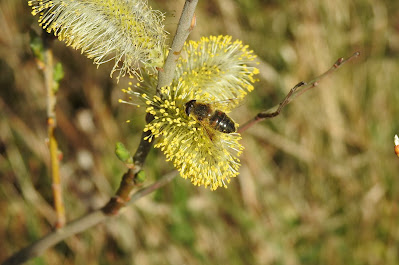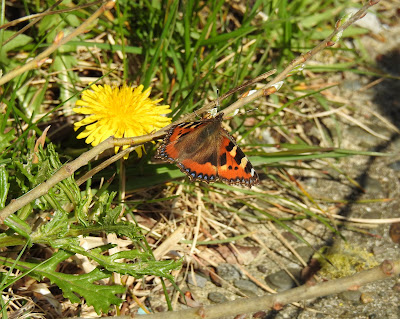Exactly a week ago I was at my client's farm near Slaidburn, in Bowland, showing some RSPB staff around, and we were looking at all the habitat creation and conservation grazing that we are doing for breeding waders. It was a dreich day to say the least, and it was difficult to say how many waders were on territory, but there were good numbers of both Curlew and Lapwing, and we had a displaying Snipe which was great!
A few days ago, I decided to have a look at a few migrant spots on the coast, as I thought that there might be a few migrants in, based on the south-easterly wind, with rain overnight. However, the south-easterly was coming off a northerly arctic airstream, and with hindsight, was unlikely to drop any birds.
I started off at the cemetery under full cloud cover with light rain, and it was very quiet. In fact, it was just a trickle of Alba Wags and Meadow Pipits overhead quiet! I then had a look in the coastal park, and it was more of the same. Time to cut my losses and head home!
Over the past few days, a female Blackbird has been collecting nest material in the garden and taking it into the ivy between us and our neighbours. So, fingers crossed they can nest successfully. I trimmed my beard recently and put the trimmings out on the lawn, and I spotted a Great Tit the other morning picking them up and flying off with them. Obviously, they were going to be used to line a nest somewhere.
At weekend Gail and I had a walk along the quay down by the Wyre estuary, and it was on a gloriously sunny afternoon. Out on the mud were 97 Redshanks and a couple of Shelducks. Further round on the estuary were three male and three female Eiders, and the males were displaying enthusiastically to the females.
There's one or two Willows dotted along the quayside, and they were flowering and attracting lots of pollinators. Nothing unusual, but good numbers of Connon Drone Fly and Buff-tailed Bumblebees. Small Tortoiseshells and Peacock butterflies were on the wing as well. Interestingly, the couple of Peacock butterflies that I saw were both worn adults that had obviously not long emerged from hibernation.
Even though it was mid-afternoon, and a Walling's ice-cream beckoned, Meadow Pipits were still heading north in ones and twos. Ice-cream procured, it was time to walk back along the quay to our car.
I ran my garden moth trap for the first time this year during the week, and all I managed to catch was a single Common Quaker. At least I didn't blank I suppose.
Earlier this week I was back at my client's farm in Bowland, making it full circle in terms of my observations, and Gav and I were looking at the breeding wader fields, and dividing them up in terms of who was going to survey which fields this spring, as part of the RSPB's Bowland Wader Surveys. There's a good network of tracks around the farm, and it is possible to drive round overlooking all the pools and scrapes, and we added a new species for the farm in the form of a pair of Gadwalls. Nothing unusual, but exciting to record them at the site.
Breeding waders were in good numbers, and we estimated twelve Curlews, 70 Oystercatchers, 20 Lapwings, eight Snipe and two Redshanks. It's hard to work out what some of the Oystercatchers were doing. Several birds were paired off and were in suitable nesting habitat, but we came across a flock of about fifty birds adjacent to one of the pools. We guessed that these birds were either migrants, or perhaps first year birds that had returned to suitable habitat.
We found a Lapwing nest close to the new scrape, on a dry piece between two flooded wheel ruts. She had obviously just started laying as the nest contained one cold egg, so one to keep an eye on. The Snipe that we put up would very probably be migrants, but the farm does support nesting Snipe. The two Redshanks will almost certainly have been a breeding pair, as a couple of years ago they returned to breed at the farm, testament to all the habitat creation that has gone on.
Lapwing nest & egg
It was a glorious morning and it most certainly had a raptor feel to it, but the only raptors we had were three Buzzards and a single male Kestrel. Just three Skylarks, eight Teal, a pair of Tufted Ducks, four Stock Doves, three Skylarks, a Song Thrush, 15 Meadow Pipits, two Siskins, a pair of Stonechats and a Raven were the best of the rest.
The forecast over the easter weekend isn't to bad, with high pressure building from Friday - Sunday, and that then decays on Monday with an Atlantic weather front. The best day for ringing in terms of the wind strength is tomorrow, so it could be a 5:30 a.m. alarm call for me!
Over on the right you will see that I have updated the totals for Fylde Ringing Group up until the end of March. There were no new species ringed for the year during the month, and no individual species made it into double figures.
Below you will find the top 4 'movers and shakers' for the year.
Top 4 Movers & Shakers
1. Goldfinch - 62 (same position)
2. Chaffinch - 23 (same position)
3. Blue Tit - 12 (same position)
4. Great Tit - 11 (straight in)







2 comments:
Nice blog Seumus. I've missed them over the winter but now it's back at it, even if it means 5.30am alarm call. Glad you found a use for the beard.
Thank you.
Post a Comment